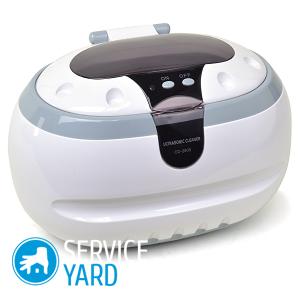DIY Ultrasonic Cleaner

Such a tool as an ultrasonic bath is included in the arsenal of not only professionals, but also home masters. The device significantly reduces the complexity of the work if you need to sterilize or clean something. And there are many more for what purposes it can be used. The topic of today's article is the do-it-yourself ultrasonic bath and its applications.
to contents ↑Application area
Using an ultrasonic device, you can clean the assembly, part or circuit board from dirt in the most inaccessible places, a darkened silver product, an inkjet printer cartridge, car nozzles and other parts that cannot be washed mechanically without damaging them.
Threaded components that cannot be washed by hand are well cleaned. Ultrasound also helps if it is necessary to remove the protective film from the surface in an inaccessible place where the tool simply cannot be reached.
Important! Such equipment has taken root in workshops for the repair of mobile gadgets, office equipment and cars. Jewelers were also able to appreciate the device. Now cleaning jewelry has become faster and more efficient.
It is convenient to sterilize medical equipment and instruments using an ultrasonic bath.
to contents ↑Process physics
Oscillations exceeding the threshold of 18000 Hz are called ultrasound. It is quite difficult to transmit the oscillation of such a frequency through the air. Therefore, the working environment for the ultrasonic bath is liquid. In this case, a large number of microscopic bubbles form in the liquid.
The higher the frequency, the larger the bubbles form, and the more pressure they exert on the surface.
to contents ↑Important! Electricity is not able to create fluctuations of this frequency, therefore, to convert the network frequency into mechanical vibrations, the device is equipped with an adjustable generator.
Benefits
An ultrasonic cleaner bath is a reservoir made of stainless steel. As a rule, the capacity of a household device is about 1 liter. This is enough to clean a small part. How to choose an ultrasonic bath? For professional use, larger bathtubs are used (5-15 liters, and sometimes more).
The advantages of an ultrasound device include:
- The absence of traces of mechanical stress on the cleaned part. Neither chips nor scratches are formed.
- Using an ultrasonic device, it is possible to easily eliminate limescale, rust, oxide layer in areas that cannot be reached.
- Ease of use. It is enough to choose a suitable environment, immerse the part in the bath and press the button. Cleaning started.
Which solvent to use?
Ultrasonic washing itself does not wash the product, but only accelerates the action of the used solvent. For this reason, it is important to choose the detergent that is best suited to eliminate this type of contamination.
Important! If the bathtub is empty or half empty, you should never turn it on. The bath must be filled at least ⅔ of the total capacity. With less filling, the voltage on the generator increases and the device may fail.
As washing liquids use:
- Special solutions such as Zestron FA +, Solins-us, etc.
- Sometimes they use white spirit and even distilled water.
- If you want to wash a metal object from rusty deposits, use a rust converter or phosphoric acid solution.
- It is convenient to clean the surface of calcareous deposits with “Anti-scale”.
to contents ↑Important! It is undesirable to use kerosene or gasoline as a detergent, as the tank heats up during operation. If you want to use gasoline or kerosene, set a short mode, during which the bath does not have time to warm up.
How to make an ultrasonic bath with your own hands?
You will need to work:
- Stainless steel bath with a capacity of up to 1 liter.
- A piece of plastic pipe - for the stand under the bath.
- 12 volt battery
- The ultrasonic emitter is 80 watts.
- Epoxy
- Copper wire with a diameter of 1.0-1.5 mm.
- Ferrite core (you can use the antenna from the radio).
- Throttle from PC power supply.
The procedure is as follows:
- Wrap a soft copper wire - 20 turns on a rod.
- Glue the ultrasonic emitter strictly in the center of the container.
- Solder the board according to the wiring diagram.
- Assemble the electrical circuit.
- Connect the power supply to a 5V winding.
Stock footage
You can find the electrical diagram on the Internet. To test the device, fill the bath, dip a piece of crumpled foil there and turn it on. If the ultrasonic bath is made correctly with your own hands, then the foil will dissolve in the places of bends. And for what purpose it is better for you to apply it - now it is up to you.
- How to choose a vacuum cleaner taking into account the characteristics of the house and coatings?
- What to look for when choosing a water delivery
- How to quickly create comfort at home - tips for housewives
- How to choose the perfect TV - useful tips
- What to look for when choosing blinds
- What should be running shoes?
- What useful things can you buy in a hardware store
- Iphone 11 pro max review
- Than iPhone is better than Android smartphones



